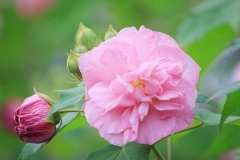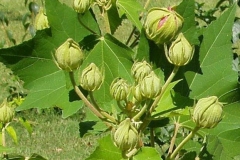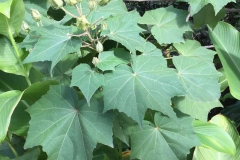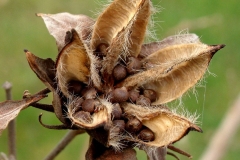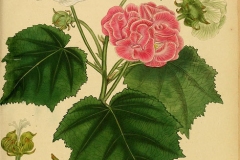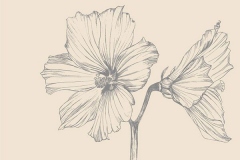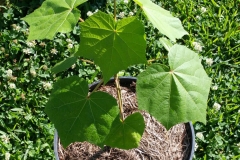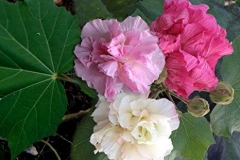| Cotton Rose Quick Facts | |
|---|---|
| Name: | Cotton Rose |
| Scientific Name: | Hibiscus mutabilis |
| Origin | Japan and China |
| Shapes | Dry, loculicidally dehiscent capsules 5-10 celled that are round and hairy and consist of fuzzy seeds |
| Taste | Acrid |
| Health benefits | Beneficial for lung ailments, persistent coughs, menorrhagia, dysuria, wounds, skin infections, gonorrhea, abscesses, bilious conditions, cancer, dyspepsia, fever, hangover, heart ailments, hypertension, neurosis, scurvy and strangury |
| Name | Cotton Rose |
|---|---|
| Scientific Name | Hibiscus mutabilis |
| Native | Japan and China |
| Common Names | Baru Landak, Botan, Changeable Rose, Chinese Rose, Confederate Rose, Confederate Rose Mallow, Cotton Rose, Mati-laki-mati-bini, Rose of Sharon, Changing Rose, Common Rose Mallow, Cotton Rosemallow, Dixie, Dixie Rose Mallow, Rose Mallow, White Mallow, land lotus, lotus bendy, meadow lotus, Cottonrose hibiscus |
| Name in Other Languages | Assamese: Shalapadma (স্হল-পদ্ম) Bengali: Sthal Padma (স্থলপদ্ম), Thul Padma, shalapadma Chinese: Mu fu rong (木芙蓉), Fu rong hua, Shan fu rong, Fu Yong, Chong Ban Mu Fu Rong Creole: Shoubak English: Confederate rose, Cotton rose, Cottonrose hibiscus, Dixie rose-mallow, Dixie rosemallow, Cotton Rosemallow Esperanto: Hibisko Estonian: Muutlik Hibisk Finnish: Villahibiskus French: rose confédérée, Caprice De Femme, Akaimhe, Rakauhai, Rap German: Filziger Roseneibisch Hindi: Sthalkamal (स्थलकमल), bala (बाला), drishtikrita (दृष्टिकृत), dewa (देवा), Padma (पद्मा), padmacharini (पद्मचारिणि), pra-paundarik (प्रपौण्डरीक), pundariyak (पुण्डरीयक), sadhu-pushp (साधुपुष्प), sal-pushp (सालपुष्प), sthal-kamal (स्थलकमल), sthal-kamalini (स्थलकमलिनी), tarani (तरणी) Hungarian: Gyapotrózsa Indonesian: Waru landak, Ngali-ngali, Saya Ngalingali Japanese: Fuyo (フヨウ), Fuyou Kannada: Neladavare, chandrakanti gida (ಚಂದ್ರಕಾಂತಿ ಗಿಡ), nelatavare (ನೆಲತಾವರೆ), suryakanti (ಸುರ್ಯಕಾಂತಿ) Kashmiri: nyovu (न्योवु), sthalapadmam (स्थलपद्मम्) Konkani: Suryakanti (सुर्यकांती) Korean: Bu yong Malayalam: Chinappratti, cēñc ṟēās (ചേഞ്ച് റോസ്) Marathi: Kapurabhendi (कापूरभेंडी) Nepali: Padma (पद्मा) Oriya: Tholopodmo Persian: ختمی الوان Portuguese: Rosa-louca Punjabi: Shalapapra (ਸ਼ਾਲਾਪਾਪਰਾ) Russian: Gibiskus izmenchivyy (гибискус изменчивый) Sanskrit: Atichara (अतिचरा), avyatha (अव्यथा), bala (बाला), drishtikrita (दृष्टिकृत), dewa (देवा), padmacharini (पद्मचारिणि), pra-paundarik (प्रपौण्डरीक), pundariyak (पुण्डरीयक), pushkarmulam (पुष्करमूलम्), pushkarnadi (पुष्करनाडी), pushkarparnika (पुष्करपर्णिका), sadhu-pushp (साधुपुष्प), salapushpa (सालपुष्प), sthalakamala (स्थलकमल), sthalampadmam (स्थलम्पद्मम्), sthalanalini (स्थलनलिनी), sthalapadmini (स्थलपद्मिनी), sthalaravinda (स्थलारविन्द), sthalejata (स्थलेजात), sthalotpalini (स्थलोत्पलिनी), sugandhamula (सुगंधमूलः), tarani (तरणी), tarpini (तर्पिनी ) Spanish: Rosa algodón, Malva rosa, Palo de la reina Swedish: Föränderlig hibiscus, Bomullshibiskus, föränderlig hibiscus Tamil: Cemparutti (செம்பருத்தி) Semburutti, malakam (மாலகம்) Telegu: Patthi Mandaram, mudugutamara (ముడుగుతామర), nettammi (నెత్తమ్మి), sthalapdmamu (స్థలపద్మము) Thai: Phudttan (พุดตาน) Urdu: Gul-e-ajaib (गुले अजायब) Vietnamese: Phù dung |
| Plant Growth Habit | Large, erect, robust, deciduous, spreading, shrub or small multi stemmed tree |
| Growing Climates | Around old hone sites, on roadsides, and in wetlands, Thickets along streams |
| Soil | Prefers a well-drained humus rich fertile soil |
| Plant Size | About 15 ft. high with about a 10 ft. spread. |
| Stem | Erect, little branched, and pubescent on the new growth |
| Leaf | Alternate, petiolate, ovate in outline, 3-7 lobed, entire to sparsely toothed, and pubescent with simple and stellate hairs |
| Flowering season | August to October |
| Flower | Solitary in the axils of the upper leaves. Calyx is 3 to 4 centimeters long, with 5 oblong-ovate lobes, connate below. Corolla is 10 to 12 centimeters in diameter, single or double, opening pale pink or nearly white, growing darker in color as the day advances. |
| Fruit Shape & Size | Dry, loculicidally dehiscent capsules 5(-10)-celled that are round and hairy and contain fuzzy seeds |
| Seed | Seeds 3 per cell, globose or reniform, glabrous or hairy |
| Propagation | From seed and also from stem cuttings |
| Taste | Acrid |
| Plant Parts Used | Leaves, flowers, roots |
| Season | September to November |
| Precautions |
|
Plant Description
Cotton Rose is a large, erect, robust, deciduous, spreading shrub or small multi stemmed tree that usually grows about 15 ft. high with about a 10 ft. spread and is densely covered with short, grayish, stellate hairs. Confederate Rose can be found around old hone sites, on roadsides, in wetlands and thickets along streams. The plant prefers a well-drained humus rich fertile soil. In Alabama it is usually cold killed back to near ground level each winter. The stems are erect, little branched, and pubescent on the new growth.
Leaves
Leaves are alternate, petiolate, and broadly ovate to orbicular ovate, 5-lobed or 5-angled, 7 to 20 centimeters long, with pointed tip, heart-shaped base, and toothed margins and pubescent with simple and stellate hairs. Leaves are bright green, hairy on the undersides and are deeply lobed.
Flowers
Flowers are solitary in the axils of the upper leaves. The most commonly cultivated form in Alabama has double flowers. Calyx is 3 to 4 centimeters long, with 5 oblong-ovate lobes, connate below. Corolla is 10 to 12 centimeters in diameter, single or double, opening pale pink or nearly white, growing darker in color as the day advances. Some varieties have flowers that do not change color. Single blooming flowers are generally cup-shaped. Bloom season usually lasts from summer through fall. Propagation by cuttings root easiest in early spring, but cuttings can be taken at almost any time.
Fruits
Fertile flowers are followed by dry, loculicidally dehiscent capsules 5-10 celled that are round and hairy and consist of fuzzy seeds. Seeds are 3 per cell and are globose or reniform, glabrous or hairy.
Traditional uses and benefits of Cotton Rose
- Leaves are anodyne, antidotal, demulcent, expectorant and refrigerant.
- With the flowers, they are applied to burns, swellings and other skin problems.
- Flowers are anti-phlogistic, depurative, febrifuge, pulmonary and stimulant.
- If used internally, it can remove heat from the blood, reduce swelling and detoxify.
- If pounded and applied externally, it relieves inflammation and reduces swelling.
- Flower’s nutritional properties are purported to be good for menopausal women.
- It balances hormones, and purifies your blood.
- Roots and leaves, ground into paste, are good for treating diabetics with leg problems.
- Abundant mucilage contained in the tissues makes the plant an effective emollient for burns.
- Leaves and flowers kill pain; expel phlegm; treat excessive bleeding during menstruation, painful urination, inflammation and snake bites.
- Decoction of the flowers is considered pectoral and is used in the treatment of lung ailments.
- Flowers and leaves are considered expectorant, cooling, analgesic and antidote to all kinds of poison in China.
- In Chinese medicine, leaves are one of the components in a medicine used for treating tuberculous lymphadenitis; the flowers for treating nasopharyngeal carcinoma.
- It is used by Dong people for migraine and otitis media; by She people for pulmonary hemoptysis, by Yao for appendicitis and epidemic parotitis, by She, Jingpo, Lisu people for menorrhagia.
- It is used for mumps; egg whites are added to dried powdered leaves and applied to affected areas.
- It is used for persistent coughs, menorrhagia, dysuria and wounds, especially burns and scalds that are slow to heal.
- Leaves and flowers applied to swellings and skin infections.
- Plant is used as emollient in Guiana.
- Infusion of flowers are used for chest and pulmonary complaints; also used as stimulant.
- They are also used as a medication for persistent coughs, bronchitis and other pulmonary complaints, menorrhagia and dysuria.
- Mucilage is also applied by midwives to facilitate expulsion in labor.
- An infusion of the red flowers of H. Rosa-sinensis is considered somewhat purgative, and is even said to cause abortion in Indonesia.
- Flowers are used for their contraceptive properties, and also for irritable conditions of the genito-urinary tract in India.
- Juice from the crushed leaves mixed with sea water is drunk to treat stomach-ache in Papua New Guinea and Fiji.
- Seeds, pounded into a pulp and mixed with water, is a cure for gonorrhea, as is the juice of the leaves.
- Decoction of these parts is considered to improve the eyesight.
- An infusion of the dried flowers is used in Malaysia as a diuretic, as well as against skin complaints and itch.
- Seeds are used in headaches and colds, and combined with pig marrow, as an application to discharging ulcers.
- An infusion of the bark is drunk to relieve coughs and tuberculosis in Papua New Guinea.
- Leaves are wrapped on bone fractures, and the stem is said to be part of an internal remedy for ulcers and internal injuries in Fiji.
- Leaves are used as a laxative and resolutive in indo- China.
- Flowers, boiled in milk, are dropped in the ear against earache.
- The flowers are used for headaches in China.
- Calyx is a folk remedy for abscesses, bilious conditions, cancer, cough, dyspepsia, dysuria, fever, hangover, heart ailments, hypertension, neurosis, scurvy and strangury.
- Seeds are used for debility, and in Taiwan, they are regarded as a gentle laxative, diuretic and tonic in Myanmar.
- Bitter root is used as a tonicin Philippines.
- The roots are used to poultice swellings of finger nodes, which remain after framboesia.
Ayurvedic Health benefits of Cotton Rose
- Cough: Make a decoction using leaves of Confederate Rose plant. Drink 10 ml twice a day.
- Heavy Menstrual Bleeding: Drink 30 ml leave decoction of Confederate Rose plant. Have it two days before your Menstrual Cycle begin.
- Dysuria: Boil 5 g fresh leaves of Confederate Rose plant with 20 ml water. Drink 15 ml thrice a day.
- Lung Diseases: Prepare a decoction using one fresh flower of Confederate Rose. Drink 36 ml twice a day.
- Swelling: Take 2 flowers of Confederate Rose. Pound them. Apply it over Swelling.
- Emollient: Add decoction of leaves and flowers of Confederate Rose in your bathing water. Take bath with it. It will soften your Skin.
Other facts
- Fiber from the bark is used for making cords and rope.
- Flowers are white in the morning, turning pink during noon and red in the evening of the same day.
- Weight of a single detached flower was 15.6 g (0.55 oz.) when white, 12.7 g (0.45 oz.) when pink and 11.0 g (0.39 oz.) when red.
- Bast fiber is sometimes used as a substitute for jute.
- Juice of the fresh flowers is supposed to increase hair growth in India.
- Young shoots and leaves are used raw or cooked as a vegetable, and the fleshy calyces are widely used to make red, fresh but sourish beverages and jams.
- Bark of H. tiliaceus is sometimes used as fodder when other food is lacking in pacific Island.
- Leaves are used as a food wrapper in Java.
- Usually no flowering is observed during December-March in Java.
References:
https://www.itis.gov/servlet/SingleRpt/SingleRpt?search_topic=TSN&search_value=21634#null
https://npgsweb.ars-grin.gov/gringlobal/taxonomydetail.aspx?id=19059
https://pfaf.org/user/Plant.aspx?LatinName=Hibiscus+mutabilis
https://plants.usda.gov/core/profile?symbol=HIMU3
https://www.cabi.org/isc/datasheet/27125
https://davesgarden.com/guides/pf/go/714/#b
https://wikivisually.com/wiki/Hibiscus_mutabilis
https://www.wikidata.org/wiki/Q266983
http://floraofalabama.org/Plant.aspx?id=2620
http://www.theplantlist.org/tpl/record/kew-2850227
https://indiabiodiversity.org/species/show/264267
https://npgstest2.agron.iastate.edu/gringlobal/taxonomydetail?id=19059
https://gd.eppo.int/taxon/HIBMU
http://tropical.theferns.info/viewtropical.php?id=Hibiscus+mutabilis
https://www.herbalpedia.com/ROSE,%20COTTON.pdf
https://en.wikipedia.org/wiki/Hibiscus_mutabilis
https://uses.plantnet-project.org/en/Hibiscus_(PROSEA_Medicinal_plants)
http://www.flowersofindia.net/catalog/slides/Changeable%20Rose.html
https://link.springer.com/chapter/10.1007/978-94-017-8748-2_21



